PEARL MILLET (BAJRA) DISEASE- SYMPTOMS & CONTROL
Introduction
- Pearl millet, Pennisetum glaucum (L.) is an annual grass belongs to the family Poaceae, grown widely in semi-arid and arid tropics of Asia and Africa.
- It is also known as bajra in Hindi, bulrush, spiked millet or cattail millets in English, Chandelles in Arabic and dukhn in French. Having very good nutritional value in terms of higher levels of protein, zinc and iron.
- Usually cultivated as a food, feed/fodder and fuel crop in too hot, too dry region or have soil constraints that prevent economic production of other staple food grain crops.
- Because of its high adaptation to draught and low soil fertility, it is considered as a hardy crop.
FUNGAL DISEASES
Ergot- Claviceps fusiformis
Symptom
- Cream to pink mucilaginous droplets of “honeydew” ooze out of infected florets on pearl millet panicles.
- Very soon the droplets dry and harden, and dark brown to black sclerotia develop in place of seeds on the panicle.
- Sclerotia are larger than seed and irregularly shaped, and generally get mixed with the grain during threshing.
- Relative humidity greater than 80% and 20 to 30 0C temperatures during flowering favours the disease.
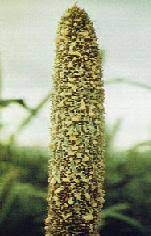
Management
- Spray Carbendazim 500g or Mancozeb 1000g /ha when 5 – 10% flowers have opened and again at 50% flowering stage.
Smut- Tolyposporium penicillariae
Symptoms
- Initial symptoms noticed when the ovaries in the inflorescence get converted into black powdery mass (sori) in diseased flowers.
- In the initial stages sori appears to be shiny green in colour that slowly converted into brown to black at
- Seed gets replaced with fine grained black spores. Sori are covered by a thin slimy layer which gets ruptured to deliver spores at maturity. On maturity, spores delivered into air which are responsible for infection of disease-free
- Primary infection takes place when severely infected grains are used for sowing and air-borne sporidia are responsible for causing infection.
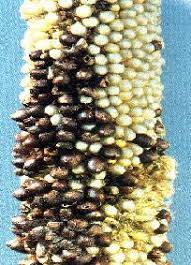
Management
The disease is air, seed and soil borne hence generally difficult to control.
Cultural methods
- Deep summer ploughing helps to incorporate spores deep into the soil.
- Inter-cropping with mung bean is also very effective.
Chemical methods
- Seed dressing with sulphur (@ 4g/kg seed.
- Foliar application of Vitavax and Plantvax effectively suppressed the smut.
- Four-time application of Zineb, Captatol and Heptaene.
Biological control
- Use Trichoderma virens (6g/kg seeds) and raw cow milk or raw goat milk (about 18h 50% dilution with water) as seed treatment.
Rust- Puccinia penniseti Zimm.
Occurrence- Usually occurs at seed developing stage, generally after the grain-filling stage thus causing little loss in grain yield. This disease appears on the leaf as round to elliptical reddish-orange pustule.The mature pustules rupture and release rusty spores.
Symptoms
- Initial symptoms appear as uredinia pustules with circular and reddish-brown to reddish orange coloured uredospores.
- Death of the diseased leaf occurs from top to bottom. At the later stages, telia replace uredinia which are black, ovoid, and subepidermal. Cluster of spores (urediniospores) are responsible for spreading the rust disease among the crops.
- The leaves get wilted from top to bottom. If disease incidence is higher more rust pustules can appear on stems and the plants will fall down.
- The pathogen survives on alternate host (brinjal, grasses), while the secondary spread takes place by air-borne spore
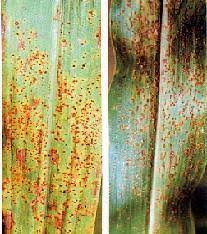
Management
- Foliar spray of Mancozeb @ 0.2% effectively controls the rust.
- Hexaconazole @ 0.1% found most effective.
- Biocontrol agents, Trichoderma spp. have been found very effective in controlling the disease.
Downy Mildew- Sclerospora graminicola
Symptom
- Symptoms often vary as a result of systemic infection.
- Leaf symptoms begin as chlorosis at the base and successively higher leaves show progressively greater chlorosis.
- Infected chlorotic leaf areas can support abundant white asexual sporulation on the lower leaf surface.
- Severely infected plants are generally stunted and do not produce panicles.
- Green ear symptoms result from transformation of floral parts into leafy structures.
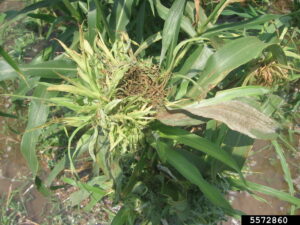
Management
- Grow downy mildew resistant varieties CO7, WCC 75, CO(Cu)9, TNAU-Cumbu Hybrid-CO9
- Transplanting reduces disease incidence. At the time of planting infected seedlings should be removed.
- In the direct sown crop, infested plants should be removed up to 45 days of sowing as and when the symptoms are noticed.
- Spray any one of the fungicides Metalaxyl + Mancozeb @500 g or Mancozeb 1000g/ha
Helminthosporium leaf spot (Bipolaris leaf spot)- Bipolaris setariae
Symptom
- Spots appears as small, brown flecks or oval to oblong or rectangular spots on leaves. Lesions may expand and coalesce.
- Early infection may cause seedling blight and severe loss may incur at early stage.
- Generally appears in the later stage of the crop when grain filling is almost over and the crop attains maturity. Thus it is of lesser economic importance.
- This pathogen survives on crop residues, stray crops, collateral hosts and a few may be seed-borne. Secondary spread of the disease may takes place with the help of air-borne conidia.
Cercospora leaf spot- Cercospora penniseti
Symptoms
- Oval lesion with dark brown margins and pale tan to grey or white centres, dotted with rows of black conidiophores. Lesions can be formed on stems also.
- This disease generally appears in the later stage of the crop when grain filling is almost over and the crop attains maturity. Thus is of lesser economic importance.
- This pathogen survives on crop residues, stray crops, collateral hosts and seed. Secondary spread may take place by air-borne spore.
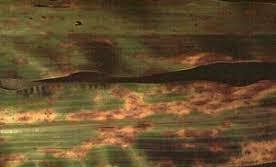
BACTERIAL DISEASES
Bacterial leaf spot- Pseudomonas syringae
Symptom
- Bacterial spots are formed on the leaves, initial symptoms appear as small, elliptical or irregular shaped spots with straw colour centre and dark margin; spots coalesce to form large bands.
- In the beginning, spots are light yellowish brown, but soon become dark brown. In advanced stage, the leaf splits along the streak giving a shredded appearance.
- All the leaves in a plant may be affected.
- This pathogen survives on crop residues in soil. Secondary spread of the disease takes place through rain-splash, facilitating bacterial cells to reach new infection sites.
- A wet and cool condition with a temperature range of around 12-25°C is most optimum for disease development.
Bacterial leaf stripe- Pseudomonas avenae
Symptom
- The leaves of pearl millet seedlings in the greenhouse shows typical water-soaked, reddish-brown stripes development and were identical to those observed in the field.
Bacterial leaf streak- Xanthomonas axonopodis pv. pennamericanu.
Symptom
- Narrow, water-soaked, transparent leaf streaks measuring 2-3 mm wide 2-15 mm long, appearing as early as at the second leaf stage of the seedling.
- Lesions soon turn red, become opaque, and at intervals may broaden into somewhat irregularly shaped oval spots.
- In severe cases, lesions may coalesce to form long irregular streaks and blotches extending across all or much of the leaf blade, with dead tissue bordered by narrow dark margins between the reddish-brown streaks.
- Abundant bacterial exudates are produced as light-yellow droplets, which dry to thin white or cream scales.
- The pathogen survives on crop residues in soil. Secondary spread of disease may take place through rain-splash facilitating bacterial cells to reach new infection sites.
- Temperature between 26 and 30oC is most favourable for this disease.
- This disease becomes more severe during spring time under warm weather conditions and becomes less serious during hot and dry summer months.
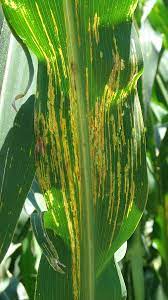
See also…
SORGHUM DISEASE- SYMPTOMS & CONTROL
SUGARCANE DISEASES- SYMPTOMS & CONTROL
MAIZE DISEASES- SYMPTOMS & CONTROL
WHEAT DISEASE- SYMPTOMS & CONTROL
RICE DISEASE- SYMPTOMS & MANAGEMENT